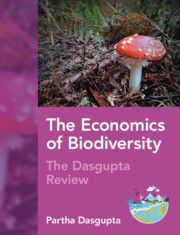Book contents
- The Economics of Biodiversity
- The Economics of Biodiversity
- Copyright page
- Contents
- List of Boxes
- Foreword
- Preface to the CUP Edition
- Preface
- Part I Foundations
- Chapter 0 How We Got to Where We Are
- Chapter 1 Nature as an Asset
- Chapter 2 Biodiversity and Ecosystem Services
- Chapter 3 Biospheric Disruptions
- Chapter 4 Human Impact on the Biosphere
- Chapter 4* The Bounded Global Economy
- Chapter 5 Risk and Uncertainty
- Chapter 6 Laws and Norms as Social Institutions
- Chapter 7 Human Institutions and Ecological Systems, 1: Unidirectional Externalities and Regulatory Policies
- Chapter 8 Human Institutions and Ecological Systems, 2:
- Chapter 8* Management of CPRs:
- Chapter 9 Human Institutions and Ecological Systems, 3:
- Chapter 10 Well-Being Across the Generations
- Chapter 11 The Content of Well-Being: Empirics
- Chapter 12 Valuing Biodiversity
- Chapter 13 Sustainability Assessment and Policy Analysis
- Chapter 13* Accounting Prices and Inclusive Wealth
- Part II Extensions
- Part III The Road Ahead
- Appendix
- Acronyms
- Glossary
- References
- Acknowledgements
- Author Index
- Subject Index
Chapter 11 - The Content of Well-Being: Empirics
from Part I - Foundations
Published online by Cambridge University Press: 10 March 2025
- The Economics of Biodiversity
- The Economics of Biodiversity
- Copyright page
- Contents
- List of Boxes
- Foreword
- Preface to the CUP Edition
- Preface
- Part I Foundations
- Chapter 0 How We Got to Where We Are
- Chapter 1 Nature as an Asset
- Chapter 2 Biodiversity and Ecosystem Services
- Chapter 3 Biospheric Disruptions
- Chapter 4 Human Impact on the Biosphere
- Chapter 4* The Bounded Global Economy
- Chapter 5 Risk and Uncertainty
- Chapter 6 Laws and Norms as Social Institutions
- Chapter 7 Human Institutions and Ecological Systems, 1: Unidirectional Externalities and Regulatory Policies
- Chapter 8 Human Institutions and Ecological Systems, 2:
- Chapter 8* Management of CPRs:
- Chapter 9 Human Institutions and Ecological Systems, 3:
- Chapter 10 Well-Being Across the Generations
- Chapter 11 The Content of Well-Being: Empirics
- Chapter 12 Valuing Biodiversity
- Chapter 13 Sustainability Assessment and Policy Analysis
- Chapter 13* Accounting Prices and Inclusive Wealth
- Part II Extensions
- Part III The Road Ahead
- Appendix
- Acronyms
- Glossary
- References
- Acknowledgements
- Author Index
- Subject Index
Summary
In Chapter 10 it was shown that despite wide differences in their foundations, three prominent styles of ethical theory interpret well-being across the generations to be the discounted sum of individual well-beings. We interpreted personal well-being to be the extent to which one’s informed desires are realised, and assumed it is a function of the individual’s standard of living. Realisation of informed desires applies to the cognitive component of happiness (some call it ‘contentment’), but not to the affective component (which can be called the ‘hedonic level of affect’) although it could have a bearing on affect. So, we now dig deeper into the content of well-being.367
In the formal models that were developed in previous chapters, the living standard was represented by the quantity of an all-purpose commodity to which the average person in society has access. We called the all-purpose commodity a consumption good. But the presumption that the sole factor in well-being is consumption may seem otiose.
- Type
- Chapter
- Information
- The Economics of BiodiversityThe Dasgupta Review, pp. 289 - 304Publisher: Cambridge University PressPrint publication year: 2024

